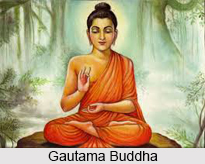 History of Buddhism in India involved with the teachings of Gautama Buddha and the tales related to Gautama Buddha and his followers. This religion was developed in the Magadha Region of Bihar. The practice of Buddhism began in Guptas and Maurayan era and declined in the medieval age with the advent of Islamic interruption through Delhi Sultanate.
History of Buddhism in India involved with the teachings of Gautama Buddha and the tales related to Gautama Buddha and his followers. This religion was developed in the Magadha Region of Bihar. The practice of Buddhism began in Guptas and Maurayan era and declined in the medieval age with the advent of Islamic interruption through Delhi Sultanate.
Gautama Buddha and Buddhism
Buddhism in India was introduced by Gautama Buddha (563-483 B.C), a prince from the small Shakya Kingdom in the foothills of the Himalayas in Nepal. Though brought up amidst lavishness, the prince left his home as a religious beggar, in order to find the meaning of existence. At first, he followed the path of strict penance but later realised that self-torture was weakening his mind rather than advancing him towards enlightenment. Then he adopted a milder style of renunciation and concentrated on superior meditation procedures. Ultimately, by continuous meditation under the Bodhi tree in Gaya, he attained an insight into the mystery of existence. His knowledge is precisely expressed as the Four Noble Truths: life is filled with suffering; the source of suffering is desire; the end of desire leads to the end of suffering; and discipline and meditation can end desire.
 Spreading of Buddhism in India
Spreading of Buddhism in India
Buddhism in India witnessed a colossal impetus in its initial stages, with the stronghold of the Mauryan dynasty and Emperor Ashoka occupying centre-stage. The Mauryan Empire scaled peak heights at the time of emperor Ashoka, who himself converted to Buddhism after the legendary Kalinga War. This heralded a long period of solidity under the Buddhist emperor. The power of the empire lies in sending immense-ambassadors to other countries to propagate Buddhism. During the 1st-3rd centuries, the Kushana Empire, under the able leadership of emperor Kanishka, were also responsible for the spread of Buddhism in other parts of Asia, and not only India. He hugely encouraged Buddhism, and it was during Kanishka`s reign that Buddha was first represented as a human form. Indian shramanas (a wandering monk in specific ascetic traditions of ancient India, including Jainism, Buddhism and Ajivika religion) can also be held responsible to have propagated Buddhism in various regions; they were also referred to as dharma masters.
Patronage of Buddhism by Indian Rulers
Buddhism in India also proliferated with the patronisation of the Buddhist monasteries by Indian sovereigns and merchants, who erected stupas over the relics of the Buddha. Archaeological evidences since 1840 (like the Nalanda complex in Bihar) have revealed a massive impact of Buddhist art, iconography, and architecture in India. Astonishingly, by the 13th century, after the Turkish invasion, Buddhism survived mainly in Bhutan and Sikkim, probably due to shift of royal patronage towards Hinduism. Buddhism in India again staged a comeback in the 20th century through European sponsorship and the Mahabodhi Society was founded in 1891. In 1956, Bhimrao Ramji Ambedkar, leader of the Untouchable wing within the Congress advocated Buddhism as a means to evade the caste system of Hinduism. By the early 1990s, there were more than 5 million Buddhists in Maharashtra. These along with the Buddhist populace in hill areas of northeast India and high Himalayan valleys (Ladakh District in Jammu and Kashmir, Himachal Pradesh, and northern Uttar Pradesh), as well as the entry of Tibetan Buddhist refugees who fled from Tibet with the Dalai Lama in 1959 and thereafter, raised the number of Buddhists in India to 6.4 million by 1991.
Buddhism in India again staged a comeback in the 20th century through European sponsorship and the Mahabodhi Society was founded in 1891. In 1956, Bhimrao Ramji Ambedkar, leader of the Untouchable wing within the Congress advocated Buddhism as a means to evade the caste system of Hinduism. By the early 1990s, there were more than 5 million Buddhists in Maharashtra. These along with the Buddhist populace in hill areas of northeast India and high Himalayan valleys (Ladakh District in Jammu and Kashmir, Himachal Pradesh, and northern Uttar Pradesh), as well as the entry of Tibetan Buddhist refugees who fled from Tibet with the Dalai Lama in 1959 and thereafter, raised the number of Buddhists in India to 6.4 million by 1991.
Forms of Buddhism in India
There are certain forms of Buddhism in India. That practiced by the Himalayan communities and Tibetan refugees are part of the Vajrayana, or "Way of the Lightning Bolt", that developed after the 7th century A.D. as part of Mahayana Buddhism. This form emphasises the intervention of the enlightened beings, which remain in this world to assist others on the path. A majority of the other Buddhists in India follow Theravada Buddhism, the "Doctrine of the Elders", which has its origin in the Sri Lankan and Burmese traditions as well as the scriptures in the Pali language. Filled with many legends, these scriptures stress a more human Buddha and an autonomous path towards illumination for everyone.
Effects on Other Religion after the Spreading of Buddhism
Buddhism in India has also affected other religions, especially in the concept of the enlightened master. For instance, one of the primary Hindu orders traces its origin to the teacher Shankara, believed by many devotees to have lived hundreds of years earlier. A different kind of renunciation appears in the cult of Sai Baba, whose two notable pioneers are Sai Baba (died 1918) and Satya Sai Baba (born in 1926). This cult mingles various meditation and devotional techniques along with advocating a humble life.




















